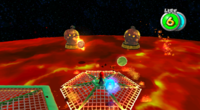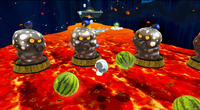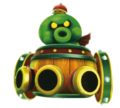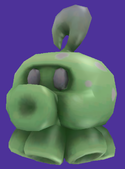Rocto
| Rocto | |||
|---|---|---|---|
![Artwork of a Rocto from Super Mario Galaxy.[1] It has subsequently been used for Super Mario Galaxy 2. This specific image was scanned from its guidebook by Shokora (talk).](https://mario.wiki.gallery/images/thumb/9/94/SMG_Octopus_Artwork.png/145px-SMG_Octopus_Artwork.png) Artwork from Super Mario Galaxy | |||
| First appearance | Super Mario Galaxy (2007) | ||
| Latest appearance | Super Mario 3D All-Stars (2020) | ||
| Member of | Octo-Army | ||
| |||
| |||
| |||
- “Your attacks won't reach those mean-looking aliens! But here's a great idea! What if you tried to bounce something back at them?”
- —Green Toad, Super Mario Galaxy
Roctos[1][2] are octopus enemies in Super Mario Galaxy and Super Mario Galaxy 2. They are giant, gray relatives of Octoombas with many pale spots and a blue appendage on their heads. They are larger than the Octoombas and they coil their tentacles around the base of their bodies. They are capable of firing projectiles from their funnels.
Their means of attack and defeat mirror how Octoroks behave in The Legend of Zelda 3D titles. The internal file designation and Japanese name[3] for Roctos suggest this was not circumstantial, and that the enemies are directly based off of them.
History[edit]
Super Mario Galaxy[edit]
In Super Mario Galaxy, these enemies mostly appear around airships, are always found in pairs, and have two varieties. The first type hides in a large barrel until approached, after which it will emerge and occasionally shoot a coconut (with a high-pitched squeak) or a fireball (with an even higher-pitched squeak) towards Mario. If he gets too far away from one, it will duck back into its barrel until he draws closer again. To defeat this type, Mario has to send back the coconuts they shoot by spinning when the coconut gets close, making it deflect and hit the Rocto instead. The second type lacks a barrel, simply standing on the ground, and as such constantly shoots regardless of how far away Mario is, even when he is not even in their line of fire. This type only shoots fireballs, and as such can only be defeated with a thrown Koopa Shell. Roctos usually guard bridges that will be released upon their defeat. The leader of the Roctos, King Kaliente, is fought twice as a boss.
Appearances[edit]
 marks missions where they are completely absent.
marks missions where they are completely absent. marks missions where they are loaded and may be visible, but cannot be encountered directly.
marks missions where they are loaded and may be visible, but cannot be encountered directly.
| With barrel, shoots coconuts and fireballs | |||||||
|---|---|---|---|---|---|---|---|
| Domes | Galaxies | Missions | |||||
| Terrace | Good Egg Galaxy | ||||||
| Engine Room | Bowser Jr.'s Lava Reactor | ||||||
| Garden | Dreadnought Galaxy | ||||||
| Without barrel, shoots fireballs | |||||||
| Domes | Galaxies | Missions | |||||
| Fountain | Space Junk Galaxy | ||||||
Super Mario Galaxy 2[edit]
In Super Mario Galaxy 2, only the barrel-hiding type reappears in the Shiverburn Galaxy where they act as the final enemy defense before facing Prince Pikante, another boss Rocto. Similarly to the first game, they guard a pathway (of rock over lava) that Mario must use to progress. However, unlike the previous game, they are found in varyingly sized groups rather than in pairs. They also appear in the final galaxy, the Grandmaster Galaxy, on the Platform Planet; this is their only appearance where defeating them is not mandatory to progress forward. They still shoot coconuts and fireballs in this game.
Appearances[edit]
 marks missions where they are completely absent.
marks missions where they are completely absent. marks missions where they are loaded and may be visible, but cannot be encountered directly.
marks missions where they are loaded and may be visible, but cannot be encountered directly.
| Worlds | Galaxies | Missions | ||
|---|---|---|---|---|
| World 5 | Shiverburn Galaxy | |||
| World S | Grandmaster Galaxy | |||
Gallery[edit]
Model from Super Mario Galaxy
Artwork of King Kaliente from Super Mario Galaxy
Artwork of Prince Pikante from Super Mario Galaxy 2
Naming[edit]
Etymology[edit]
The English name "Rocto" is a portmanteau between "rock" and "octo," the prefix in "octopus." It is comparable in origin to to the enemy's Japanese name「オタロック」(Otarokku), as well as the English name for Octorok. This name was first published on the English version of Mario Portal in 2022. Beforehand, there was no published English name for the enemy. In the original Super Mario Galaxy, it is informally referred to as a "mean-looking alien" and "octopus"[4] by members of the Toad Brigade. This reflects the original Japanese release of Super Mario Galaxy and other localizations for the game, in which the enemy is only referred to as an octopus. Guidebooks for Super Mario Galaxy and Super Mario Galaxy 2 similarly do not name the enemy, varyingly referring to it as an "octopus," "squid," or "cannon." An officially licensed trading card for King Kaliente, a related character, refers to him as a "Blooper-octopus" and this potentially is applicable to Rocto. "Octopus" is applied to the enemy in the 2015 English localization of the Super Mario Bros. Encyclopedia.[5] Because this was the name for the enemy's article on Super Mario Wiki from 2010 to 2021, the use of this nondescript name in the encyclopedia is potentially a consequence of circular reporting.
Internal names[edit]
| Game | File | Name | Meaning
|
|---|---|---|---|
| Super Mario Galaxy Super Mario Galaxy 2 |
ObjectData/OtaRock.arc | OtaRock | Ota Rock |
Names in other languages[edit]
| Language | Name | Meaning | Notes |
|---|---|---|---|
| Japanese | オタロック[6][7][8] Otarokku |
From「オクトパス」(okutopasu, "octopus") and「ロック」(rokku, "rock"); likely derived from「オクタロック」(Okutarokku, "Octorok") | |
| French | Octopus[9] | - | |
| German | Oktopus[10] | Octopus | |
| Italian | Polipo[11]:127 | Octopus | |
| Polporoccia[11]:159 | Portmanteau between polpo ("octopus") and roccia ("rock") | ||
| Spanish | Rocapulpo[12] | Portmanteau of "roca" ("rock") and "pulpo" ("octopus") |
Notes[edit]
- The data for Super Mario Galaxy contains a model for an unused enemy resembling a Rocto with short suction cup-shaped arms under the filename "OtaJack."[13] This fits the theme of Rocto being "OtaRock," King Kaliente being "OtaKing," and the later Prince Pikante being "OtaPrince."
References[edit]
- ^ English Super Mario Galaxy entry on the official Mario Portal. nintendo.co.jp. Retrieved August 13, 2022. (Archived August 12, 2022, 23:39:09 UTC via archive.today.)
- ^ English Super Mario Galaxy 2 entry on the official Mario Portal. nintendo.co.jp. Retrieved August 13, 2022. (Archived August 12, 2022, 23:39:46 UTC via archive.today.)
- ^ Sakai, Kazuya (ambit), kikai, Akinori Sao, Junko Fukuda, Kunio Takayama, and Ko Nakahara (Shogakukan), editors (2015). 『スーパーマリオブラザーズ百科: 任天堂公式ガイドブック』. Tokyo: Shogakukan (Japanese). ISBN 978-4-09-106569-8. Page 127, 158.
- ^ "Stupid octopuses blocking my way! I bet a few shells would take care of that little problem!" – Toad during "King Kaliente's Battle Fleet" (12 Nov. 2007). Super Mario Galaxy by Nintendo EAD Tokyo. Nintendo of America.
- ^ Roberts, Rachel, and Cardner Clark, editors (2018). Super Mario Bros. Encyclopedia: The Official Guide to the First 30 Years (First English Edition). Translated by William Flanagan and Zack Davisson. Milwaukie: Dark Horse Books. ISBN 978-1-50670-897-3. Page 128, 161.
- ^ Aoyagi, Masayuki, editor (2007). 『スーパーマリオギャラクシーコンプリートガイド』(Super Mario Galaxy Complete Guide). Tokyo: Enterbrain (Japanese). ISBN 978-4-7577-3943-7. Page 362.
- ^ Tachibana, Tadashi, Isamu Horie, Shinji Kutsuzawa, Itaru Nakatani, Seishiro Fuwa, Kimihara Hongo, and Toshimune Suzuki (2010). 『スーパーマリオギャラクシー2 任天堂ゲーム攻略本』. Tokyo: ambit (Japanese). ISBN 978-4-8399-3630-3. Page 18.
- ^ Sakai, Kazuya (ambit), kikai, Akinori Sao, Junko Fukuda, Kunio Takayama, and Ko Nakahara (Shogakukan), editors (2015). 『スーパーマリオブラザーズ百科: 任天堂公式ガイドブック』. Tokyo: Shogakukan (Japanese). ISBN 978-4-09-106569-8. Page 127, 159.
- ^ Ardaillon, Joanna, and Victoria Juillard-Huberty, editors (2018). Super Mario Encyclopedia. Translated by Fabien Nabhan. Toulon: Soleil Productions (French). ISBN 978-2-3020-7004-2. Page 127, 159.
- ^ Scholz, Sabine, and Benjamin Spinrath, editors (2017). "Super Mario Galaxy" in Super Mario Encyclopedia - Die ersten 30 Jahre : 1985-2015. Translated by Yamada Hirofumi. Hamburg: Tokyopop (German). ISBN 978-3-8420-3653-6. Page 127.
- ^ a b Sakai, Kazuya (ambit), kikai, Akinori Sao, Junko Fukuda, Kunio Takayama, Ko Nakahara (Shogakukan), and Marco Figini, editors (2018). Super Mario Bros. Enciclopedia. Translated by Marco Amerighi. Milan: Magazzini Salani (Italian). ISBN 889367436X.
- ^ Sakai, Kazuya (ambit), kikai, Akinori Sao, Junko Fukuda, Kunio Takayama, and Ko Nakahara (Shogakukan), editors (2017). Enciclopedia Super Mario Bros. 30ª Aniversario. Translated by Gemma Tarrés. Barcelona: Editorial Planeta, S.A. (European Spanish). ISBN 978-84-9146-223-1. Page 127, 159.
- ^ TCRF. Super Mario Galaxy/Unused Models § OtaJack. The Cutting Room Floor. Retrieved February 20, 2020.






